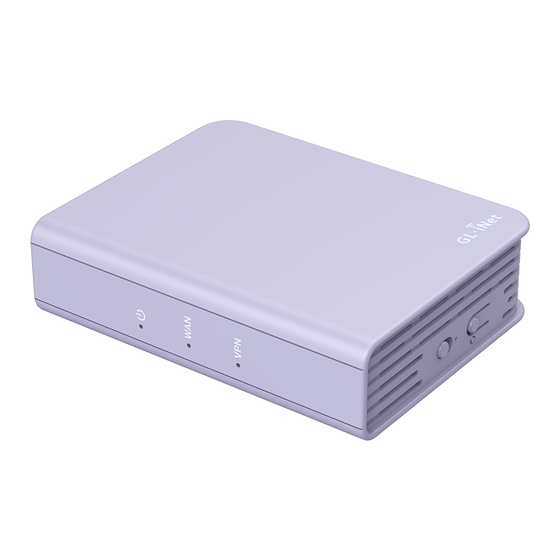
Table of Contents
Advertisement
Quick Links
Advertisement
Table of Contents

Summarization of Contents
Getting Started with GL.iNet Brume
Power on the Router
Connect the USB Type-C power cable to the router and a power adapter.
Connect to the Router via LAN
Connect your device to the LAN port of the router using an Ethernet cable.
Connect via USB Type-C Cable
Connect your computer to the router's USB Type-C port for network access.
Access the Web Admin Panel
Open a web browser and navigate to the router's IP address to access the administration interface.
INTERNET Connection Methods
a. Cable Connection Setup
Connect the router to a modem or main router via Ethernet cable for internet access.
b. Repeater Mode Configuration
Extend existing wireless network coverage by connecting the router to another Wi-Fi network.
c. USB 3G/4G Modem Connection
Connect to the internet using a compatible USB 3G/4G modem.
d. Tethering via Smartphone
Share your smartphone's internet connection with the router using a USB cable.
WIRELESS Network Configuration
1) 2.4G WiFi Settings
Configure the 2.4GHz Wi-Fi network name (SSID), security, and other parameters.
2) WiFi Dongle Support
Add Wi-Fi functionality to compatible router models using supported USB dongles.
FIRMWARE UPGRADE
5.1 Online Firmware Upgrade
Check for and install the latest firmware version directly from the internet.
5.2 Upload Firmware File
Upload a firmware file from your computer to update the router's firmware.
5.3 Auto Upgrade Schedule
Configure the router to automatically download and install firmware updates.
FIREWALL Configuration
6.1 Port Forwarding Setup
Allow remote access to specific computers or services within the local network.
6.2 Open Ports on Router
Configure specific ports to be publicly accessible for router services like web or FTP.
6.3 DMZ Configuration
Expose a specific computer to the internet, redirecting all inbound packets to it.
VPN Setup and Configuration
a. OpenVPN Client and Server
Set up and manage OpenVPN connections for secure remote access or network routing.
b. WireGuard VPN Setup
Configure WireGuard clients and servers for fast, modern, and secure VPN connections.
c. VPN Policies for Traffic Routing
Define rules to route specific traffic through VPN while other traffic uses normal internet.
APPLICATIONS and Features
8.1. Install Plug-ins
Manage and install additional software packages (plug-ins) to extend router functionality.
8.2. Internet Kill Switch
Automatically block internet access if the VPN connection drops to prevent data leaks.
8.3. File Sharing Setup
Configure the router to share files from connected storage devices across the local network.
8.4. DLNA Server Functionality
Enable the router to act as a DLNA server, allowing media streaming to network devices.
8.5. DDNS Dynamic DNS Service
Map a dynamic IP address to a static domain name for remote access.
8.6. Cloud Management Setup
Configure and manage routers remotely using the GL.iNet cloud service.
MORE SETTINGS
9.1. Admin Password Management
Change the password for accessing the router's web administration panel.
9.2. LAN IP Address Configuration
Set or modify the router's local IP address to avoid conflicts with other network devices.
9.3. Time Zone Settings
Set the router's time zone to accurately record activity logs and timestamps.
9.4. MAC Address Cloning
Clone a client device's MAC address to the router, useful for network authentication.
9.5. Custom DNS Server Settings
Configure custom DNS servers to prevent leaks or improve privacy and security.
9.6. Button Function Assignment
Customize the function of the router's physical mode switch.
9.7. Network Mode Selection
Choose the router's operating mode (Router, Access Point, Extender, WDS) based on usage scenarios.
9.8. Revert Firmware to Factory Defaults
Reset the router to its original factory settings, erasing all configurations and data.
9.9. Advanced Configuration Access
Access the LuCI web interface for advanced system logs and configurations.
Troubleshooting Common Issues
10.1. LED Indicator Status Guide
Understand the meaning of different LED light patterns for router status indication.
10.2. Router Repair or Reset Procedures
Steps to repair network issues or reset the router to factory default settings.
10.3. Debrick Router via Uboot Failsafe
Recover a 'bricked' router by reinstalling firmware using the Uboot failsafe mode.
10.4. Change WAN to LAN Port Functionality
Reconfigure the WAN port to function as an additional LAN port for increased connectivity.
10.5. Captive Portal Connection Troubleshooting
Resolve issues when unable to access captive portals on public Wi-Fi hotspots.
10.6. Using the GL.iNet Mobile Application
Guide on how to use the GL.iNet app for router setup and management.
10.7. Accessing the Web Admin Panel Issues
Troubleshoot problems preventing access to the router's 192.168.8.1 web interface.
10.8. Extensible Authentication Protocol (EAP) Connection
Connect to Wi-Fi networks requiring EAP authentication using username and password.
10.9. GoodCloud Device "Deactivated" Error
Resolve 'Deactivated' status for devices in GoodCloud by ensuring internet connection and correct region.





Need help?
Do you have a question about the GL-MV1000 and is the answer not in the manual?
Questions and answers